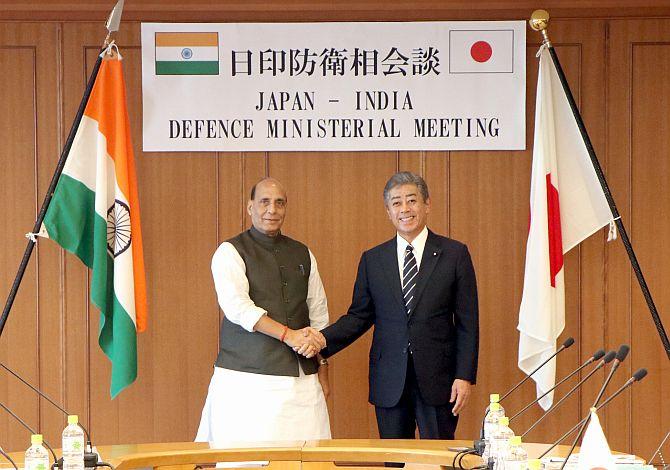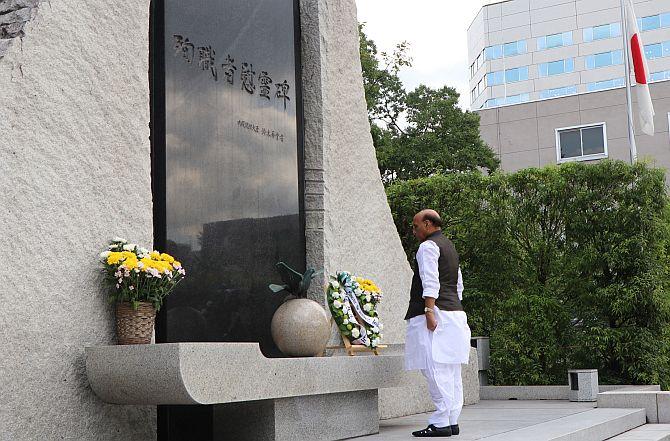September 12, 2019 19:22 IST
'Singh apprised the Japanese leaders about Islamabad's 'evil design' on Kashmir at a time when Pakistan has decided to internationalise the issue,' points out Dr Rajaram Panda.

IMAGE: Defence Minister Rajnath Singh with Japanese Prime Minister Abe Shinzo in Tokyo.
Defence Minister Rajnath Singh made two bilateral visits to Japan from September 2-3 and to South Korea from September 5-6.
Both visits are hugely significant in view of the unfolding geostrategic churning in the Indo-Pacific region.
The minister had the opportunity to have meaningful dialogue and exchange of views with his counterparts in both Japan and South Korea on bilateral and regional issues for securing peace and stability in the larger Indo-Pacific region.
In Japan, Singh co-chaired the annual defence ministerial dialogue with his counterpart Takeshi Iwaya.
This dialogue aimed to further strengthen the India-Japan Special Strategic and Global Partnership.
Both leaders also had wide-ranging discussions to enhance the bilateral defence and security engagement between the two countries.
Singh also called on Prime Minister Abe Shinzo.
In reflection of their growing congruence in defence ties, both India and Japan have already decided to go for joint development of major military platforms.
During Singh's visit, specific proposals such as ventures were discussed.

IMAGE: Defence Minister Rajnath Singh with his Japanese counterpart Takeshi Iwaya in Tokyo.
A major highlight of Singh's visit was the deliberation he had with his Japanese counterpart on the long-pending issue of supply of the US-2 amphibious aircraft by Japan to India.
Indeed, the entire spectrum of bilateral defence cooperation was reviewed.
The talks also covered deliberation on the overall situation in the Indo-Pacific region where China has been increasing its military presence and strategic footprint.
India, Japan and the US have been part of the annual Malabar maritime exercise which is aimed at achieving greater inter-operability among navies of the three countries.
The trilateral maritime exercise Malabar will be held from late September to early October this year.
What is significant to note is that the visit took place amid rising tension between India and Pakistan over the Kashmir issue and therefore Singh apprised the Japanese leaders about Islamabad's 'evil design' on Kashmir at a time when Pakistan has decided to internationalise the issue.
That the defence minister raised the issue with his Japanese counterpart of China rallying Pakistan on the central government's decision to scrap the special status of Jammu and Kashmir was in congruence with India's diplomatic outreach to explain its position on Kashmir to countries friendly to it.
On its part, India continues to exert diplomatic pressure on China taking the case of navigational freedom in the Indo-Pacific zone.

IMAGE: Defence Minister Rajnath Singh inspects a guard of honour at the Japanese defence ministry along with his Japanese counterpart Takeshi Iwaya in Tokyo.
The Indo-Japan statement comes days after New Delhi raised pitch against Beijing's muscle-flexing in the disputed South China Sea to counter its campaign against the Article 370 decision taken by the Narendra Modi government.
The joint statement issued after a bilateral meeting with Iwaya observed: 'The ministers recognised that peace and stability of the Indian and Pacific Oceans are crucial for ensuring prosperity of the Indo-Pacific region and the entire world, and had a frank exchange of views on the current security situation in the Indo-Pacific including developments on the Korean Peninsula and in the South China Sea.'
At his meeting with Abe, Singh briefed the Japanese prime minister that Jammu and Kashmir was an integral part of India and abrogation of Article 370 benefited the people of the northern state.
Singh explained Abe that Pakistan has no locus standi in Jammu and Kashmir.
This explanation was significant as Abe is expected to meet Modi on the sidelines of the United Nations general assembly next fortnight.
The joint statement also referred to the October 2018 Vision Statement of Modi and Abe in which the two Asian leaders reiterated their unwavering commitment to working together towards a free and open Indo-Pacific.
India and Japan are set to have the first foreign and defence ministerial Dialogue (2+2) ahead of the Japan-India annual summit later this year for advancing cooperation towards peace and prosperity of the Indo-Pacific region.
Both sides also expressed resolve to continue the Japan-India-US trilateral mine-countermeasures exercise. MINEX had taken place last July.

IMAGE: Defence Minister Rajnath Singh pays homage to the martyrs of the Japanese self-defense forces, at Ichigaya, Tokyo.
India and Japan have developed strong ties over the last five years.
This has been deepened further during the time of Abe and Modi in office owing to the personal chemistry both have developed.
It would not be wrong to say that the two countries are natural allies in the field of defence and security.
While in Japan, Singh invited Japanese companies to participate in the 11th Defence Expo 2020, scheduled to be held in Lucknow from February 5-8, 2020.
Deepening and strengthening defence and military ties in mind, Singh visited the Hamamatsu air base in Japan's Shizuoka prefecture, where he was briefed on the functioning of F-15 fighter aircraft and Kawasaki trainer plane.
Singh himself spent some time in checking out the trainer plane.
Besides this, Singh also visited the Japan Marine United Yokohama shipyard Isogo works in Yokohama.

IMAGE: Defence Minister Rajnath Singh and Defence Secretary Dr Ajay Kumar at the Shin-Yokohama railway station before embarking for the Hamamatsu air base.
China's recent military advance in the South China Sea, especially in Vietnamese waters, has unnerved many countries in the region.
Tension is heightened since July after China deployed a large number of survey vessels in Vietnamese waters, including around areas where India's ONGC has oil exploration projects.
South China Sea is a huge source of hydrocarbons.
China has an eye on this precious resource, which is why it claims to over 90 per cent of this oceanic space.
Several other ASEAN member countries, including Vietnam, the Philippines and Brunei, have counter claims.
In view of this changing geostrategic dynamics, the US has been pushing India for a bigger role in the Indo-Pacific, seen as a move to contain China's growing clout in the region.
In November 2017, India, the US, Australia and Japan gave shape to the long-pending "Quad" Coalition to develop a new strategy to keep the critical sea routes in the Indo-Pacific free of any influence.
Singh-Iwaya joint statement said both sides explored possibility of cooperation in third countries in the Indo-Pacific region through various initiatives that would further ensure peace and stability.
The two sides also reviewed overall bilateral defence ties and underlined the importance of increasing cooperation between the two air forces including fighter aircraft cooperation.
The two ministers also welcomed progress in negotiations on the Acquisition and Cross-Serving Agreement (ACSA).
Strengthening cooperation in the area of defence equipment and technology is indeed essential for further accelerating the cooperation between the two countries.
The joint statement highlighted this critical aspect.
In further move in taking the relations higher than the present, the first 2+2 meeting - high-level discussions between foreign and defence ministers of the two countries - on strategic and defence issues shall take place in the coming weeks in the run-up to the annual Modi-Abe summit scheduled to be held in India in December.
Both Modi and Abe met in Vladivostok on the margins of the Eastern Economic Forum on September 5, when Singh was in Korea after visiting Japan.
During the brief talks, both leaders agreed to further deepen cooperation in the strategic Indo-Pacific region as well as broaden joint projects in Africa.
This was the third meeting between Modi and Abe in 2019 after the G-20 meeting in Osaka and the G-7 summit in Biarritz, France.
No comments:
Post a Comment